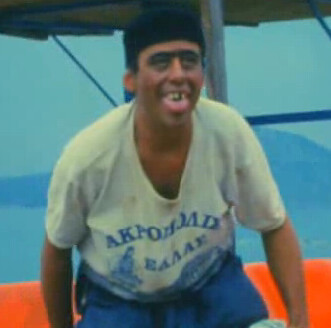
Today, after a job me and my father had at the beautiful village of Kourouni in the Kymi region of Evia, an old idea flashed my mind: to find the old dirty railway track carrying the lignite ore from the Agios Loukas mine area, about 4 km north of Aliveri to feed the neighouring DEH power plant. As a child, I have printed on my mind a scecne while being with my father and Katerina on a business trip to the southern Evia town of Karystos, around 1981: entering the town of Aliveri, a railway crossing barrier was descending, with its keeper blocking us the road; after a few seconds, a tiny locomotive with a line of empty railcars appeared, heading to Agios Loukas region.
I never forgot this scene. I had always on mind of visiting these areas to find again the old train. So there I was. My father had no objection on accompanying me, the day was great, being early in the area, not late and trying to hurry to get back in Halkida, ready to find the train of my childhood.
After entering Aliveri, the tracks were running where now the Aliveri ring road lies to the direction of the power plant and the sea. In the beginning of the '90s, the tracks in the town of Aliveri were stripped off. In the opposite direction, the road was leading to Agios Loukas. After leaving Aliveri, there was almost no sign of railway tracks. Fortunately, my father as inspector of such installations around the island was a good guide for my search. Now the Agios Loukas mines are still under the DEH control, but far away from their initial purpose, as today they are used as a metallic constructions workshop for various DEH plants around the country.
The workers' union at the Aliveri plant had the initiative to preserve their industrial heritage. A small museum for the mines is created, having items from the daily work of the miners and the railway workers. But my point was to distinguish the lines in the dust and to track them down on pictures and words before they are lost forever (Something that has already happened).
So, the remains of the line are only visible in front of the junction road to Agios Loukas and the DEH mines, just before the bridge. Another, much more preserved part of the line lies beyond a collapsed bridge over the creek Xyropotamos that runs through the mines area and was used possibly for discarding the ash at the open fields, produced by the lignite combustion at the plant, far away from the town. But this part of the line deserves further exploration, since it is not accessible by car, but only by walking on it.
In the area of the mines one can find the steam and diesel locomotives (not in good condition) that were hauling the railcars between the plant and the mines plus some ore and diesel carrying railcars. These ones are standing in the middle of a circular plain, possibly used for manoeuvres and shunting, plus a very well preserved draisine for carrying the railway staff and for maintaining the line. Unfortunately there was none of the DEI personnel to ask about the history of these unique pieces of the country 's industrial heritage. I hope to collect more information about these deeds some other day. If you are a train enthousiast, I think that this place deseves a visit.
